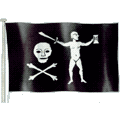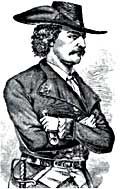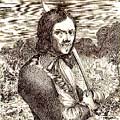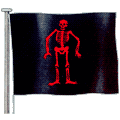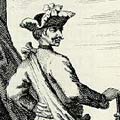
Famous Pirates and Privateers J-L 
 | |
Captain Jackman |
|
Jan Jansz |
This Dutch privateer joined the Barbary corsairs and in 1627 led a Muslim fleet to Iceland, where they took slaves and plunder. |
Henry Jennings |
Jennings hunted Spanish and French merchantmen during the War of the Spanish Succession (1702-1713). The governor of Havana sent a salvage crew to southeastern Florida to recover the cargo of silver being transported by a Spanish treasure fleet which perished in a hurricane in July 1715. Together with three small ships, Jennings and some 300 men left Jamaica came upon the salvagers. They drove off about 60 soldiers and their booty came to some 350,000 pesos. While returning to Jamaica, Jennings seized a Spanish ship laden in rich cargo and another 60,000 pesos. The governor of Jamaica, who was worried about reprisals from the government, warned Jennings about his activities. Jennings left Jamaica and found a new base of operations at New Providence Island in the Bahamas. In 1717, the English government offered a pardon which Jennings accepted in Bermuda. |
John Paul Jones |
Scottish born Jones became an American hero in the War of Independence. He attacked ships in British waters and was condemned as a traitor and pirate. Later a rear-admiral in the Russian Navy, he died in France. |
Margaret Jordan |
|
  | |
James Kelley |
In 1680, John Williams captured James Kelley from a slave ship off the coast of West Africa. In 1681, Kelley helped Williams rescue John Cook other Caribbean pirates. After an argument over the capture of a Spanish ship, Kelley left Williams and joined Cook aboard the Bachelor's Delight and they plundered the South American Pacific coast until 1688 when Cook died and Edward Davis took command of the ship. While in Jamaica, Kelley left Davis' company, accepted a pardon from the local government, and accepted a stint as a privateer. After a few months, Kelley helped seize a sloop and was put in charge of it as Captain. Under the alias James Gilliam, the captain set sail for the Indian Ocean. While in the East Indies, Kelley reunited with his old ship, the Bachelor's Delight becoming its quartermaster. In 1692, the pirates captured the Unity near Bombay. The defeated crew of the Unity joined the pirates, put their officers out to sea, and elected Kelley as their new captain. From there, Kelley sailed to northwest India. While in harbor, Kelley and 20 others were arrested stealing supplies during an earlier stop while onboard the Bachelor's Delight. The prisoners were forcibly converted to the Muslim faith and several of them died while undergoing circumcision. Kelley remained there for several years. Around 1696, Kelley pirated a boat and headed back to Bombay. There he joined the East Indian ship Mocha. Eight days after leaving port, the crew mutinied, and with newly elected Ralph Stout as its captain, became very wealthy pirates. In May 1698, the Mocha anchored at Saint Mary's Island. Kelley having much booty decided to join William Kidd who was heading home. This decision cost him his life, as unknown to Kelley, the authorities were hunting for Kidd. When Kidd landed at Boston, he was arrested as was Kelley. Kelley was taken to England to be tried for his crimes. Kelley was found guilty and hanged in 1701. While awaiting his fate, Kelley wrote his memoirs which were later published as "A Full and True Discovery of all the Robberies, Pyracies and Other Notorious Actions of James Kelley." |
Walter Kennedy |
Kennedy was a pickpocket and burglar before sailing from New Providence Island in the Bahamas in 1718 with Howell Davis. After Davis' murder in June 1719, Kennedy attacked the fort at Principe Island to avenge Davis' death. Kennedy was given second-in-command by the crew of the Rover in appreciation of his bravery. Bartholomew Roberts was in supreme command. They sailed to Brazil where they captured a Portuguese ship carrying rich booty. While Roberts was on a captured sloop, Kennedy took both the Rover and the prize. The crew wanting to go home and split up their spoils prompted Kennedy to give the Portuguese ship to a captive English captain. Kennedy decided to go to Ireland, but he was not much of a navigator and wrecked the Rover on the coast of Scotland. The majority of his crew were captured and hanged, but Kennedy escaped going to Dublin. He eventually returned to England where he set up a house of prostitution supplementing his income derived from burglary. One of his prostitutes turned him in to the authorities for robbery. Recognized in prison, he was hanged for piracy in 1721. |
William Kidd |
Captain Kidd was a wealthy New York merchant who had previously served as a privateer against the French in the West Indies. He was commissioned in 1696 by Massachusetts Royal Governor Lord Bellomont to capture Blackbeard, but after a series of misfortunate events, decided to change course and began his career in piracy raiding vessels in the India Ocean. Until his dying day, he denied being a pirate. Upon his return to America in 1699, he was arrested for piracy and shipped to London to stand trial. Found guilty, he was sentenced to be hanged at Execution Dock. It took two attempts to successfully hang him after the rope broke the first time. Tarred and wrapped in chained, his body suspended in an iron cage at Tilbury Point which for years served as a warning to other would-be pirates. |
Lady Mary Killigrew |
The Killigrew family were secret backers of piracy in Cornwall. In 1583, a Spanish merchant ship was driven into Falmouth by storms. Lady Killigrew led a boarding party onto the vessel, killing the crew, and stealing the cargo. She was sentenced to death for piracy, but was let off. |
  | |
Jean Lafitte |
Jean Lafitte practiced piracy and privateering out of Barataria Bay, south of New Orleans. With over 10 ships, he and his crew raided British, American, and Spanish ships, among others. Due to his frequent trips to various worldwide coastal ports, many citizens in New Orleans traded with his band of pirates. Captain Lafitte was famous for his cleverness. Once, when arrested by a certain governor, Captain Lafitte failed to show up at his trial. The governor offered a bounty for his capture, but Lafitte offered double that amount for the capture of the governor. In 1814, British officials offered Captain Lafitte monetary rewards, amongst other inducements, in return for his help in attacking New Orleans. Lafitte notified the officials at New Orleans. They paid little head to his warnings. A few weeks later a small Naval fleet attacked. Later that same year, General Andrew Jackson accepted Captain Lafitte's aid in combat with the British. In return for their bravery during a battle in 1815, they were pardoned by President Madison. During increased naval activity, Captain Lafitte and his crew sailed towards the Spanish occupied territory of Texas. Taking over Galveston, he reestablished his pirating activities. Efforts were made to run him out of Galveston and he left, but only after burning the entire settlement. Captain Lafitte and his brother continued pirating around Central American ports until his death in 1821. Mention is made of Jean Lafitte in this article about U.S. Marshall Duplessis. A quote from the article: "Jean Lafitte, a self-described privateer, was revered by many in New Orleans but he was a thorn in the side of Territorial Governor William Claiborne." |
Mrs. Peter Lambert |
|
Oliver le Bouché |
In 1716, Captain le Bouche; sailed in consort with Captain Benjamin Hornigold and later with Captain Samuel Bellamy. Captains le Bouche and Bellamy plundered both French and English ships near the Virgin Islands until a storm separated them in early 1717. In July 1718, when Woodes Rogers was made governor of the Bahamas, Captain le Bouche fled to the West African coast. Captain La Bouche, Thomas Cocklyn and Captain Howell Davis sailed in consort for a time, then separated ways. On his way towards the Red Sea in 1720, his ship became wrecked on the island Mayotte in the Comoro Islands. In 1721, Captain le Bouche was living on Saint Mary's Island near Madagascar. He and Captain John Taylor began sailing together after Captain Taylor gave him command of the Victory. At Reunion Island they captured a Portuguese ship which was loaded with booty. After returning to Saint Mary's Island they divvied up the loot and parted company in December. Captain Taylor headed for the West Indies and Captain La Bouche sailed to Madagascar. It is believed that Captain le Bouche ended his life of piracy making his home on Reunion Island. |
François le Clerc |
This French privateer led eight ships and 330 men attacking Spanish ships off Puerto Rico and Hispaniola, and sacked the port of Santiago de Cuba. He was the first European to settle in St. Lucia, and from Pigeon Island, attacked passing Spanish vessels. |
Pierre le Grand |
Captain le Grand was the first pirate to settle on Tortuga Island. Le Grand and 28 men captured the flagship (a galleon) of the Spanish treasure fleet. Captain le Grand spotted a galleon lagging behind a Spanish treasure fleet off Cape Tiburon in western Hispaniola. After a successful attack at night, the ship's Captain surrendered. Le Grand drafted a few of its crew into service, put the rest of the crew ashore and sailed home for France. |
William Lewis |
Lewis was an accomplished linguist, able to speak fluently most of the native languages of the Caribbean as well as Spanish, French, and English. Already famous by 1717, while serving under his mentor Captain Banister, Lewis was captured and suspended like a flag from the mizzen, but somehow managed to escape. On another adventure, he attacked and plundered a French 24 gun man-o-war aboard his smaller and lesser-armed schooner. This among other events helped thrust him into the hierarchy of the Brethren of the Coast. On another occasion, Lewis was captured by Spaniards and was taken to Havana to be hanged, but he escaped with a few other prisoners. During their escape, they stole a canoe. With it, they overtook a piragua. Then used the piragua to capture a sloop, and so until he eventually had a fine man-o-war with a crew of more than fifty. He renamed this ship the Morning Star and began to terrorize the Atlantic coast from the Spanish Main all the way north to Virginia. Not until 1727 would Lewis make a fatal mistake when he happened upon a wonderful vessel off the Carolina coast. As he approached the prize, he ran up his colors and the ship attempted to outrun him. Lewis gave chase and a running sea battle started. The Morning Star was faster and it looked like she would surely overcome the slower trading ship. In the ensuing battle, the other ship managed to take out Lewis' fore and main top masts. In a fit of insanity Lewis clambered up the top mast and began pulling his hair out and throwing it in the wind. As he did this, he shouted "Good Devil take this till I come!" Remarkably, the Morning Star then sped up and overtook the other vessel. That night, members of the crew continued to remark at how Lewis had managed to overtake the other ship after he had made a pact with the devil. The superstitious men, fearing for their lives, murdered Lewis in his sleep. |
François l'Olonoise |
l'Olonoise was a violent and cruel pirate whose torturous treatment of his captives made him the most infamous of all pirates. As a child he was an indentured servant. As a young man, he joined a band of slaves, criminals and other scoundrels and became for a time a successful buccaneer. He was notorious for cutting prisoners to bits in an act of rage, then cutting out their tongues. On one occasion, he cut out a prisoner's heart and starting chewing it while questioning him. After becoming stranded on the island of Las Pertas, he was found by local natives and was murdered in a horrendous fashion, a just end for the insane butcher. |
Edward Low |
Captain Edward "Ned" Low started his career as a Boston ship rigger then eventually turned to a more profitable lifestyle as a pirate. After capturing a Nantucket whaler, Low made the ship's commander eat his own sliced off ears, sprinkled with salt, before he killed him. This earned him a reputation as an extremely cruel brute. When he captured the Spanish galleon Montcova, he personally slaughtered fifty-three officers and made one Spaniard eat the heart of another before killing him. His own crew finally set him adrift in an open boat without provisions. Two days later, a French ship rescued him, but upon discovering who he was, the French gave him a quick trial and hanged him.
|
George Lowther |
Captain Lowther was First Mate on board the Gambia Castle, a slaving ship for the Royal Africa Company. Joining forces with Captain Massey, an army officer who was appalled at the conditions aboard ship, they took over the ship, leaving behind its captain who was on shore attending to business, then renamed the ship the Delivery. Eventually they parted ways, Massey commanding the Delivery, and Lowther in charge of a smaller sloop from a previous plunder called the Happy Delivery. On one occasion, while careening the Revenge, they were attacked by Indians and escaped with meager supplies on board. By 1722, prosperous again, Lowther had to once again careen his ship. In Blanquilla, a small but well concealed island, they had almost finished the job when the sloop Eagle, commanded by Walter Moore, spotted the ship. Lowther and his crew tried to get away but weren't able to get far enough away from the island in time, so they returned and hid on the island. Marooned on the island, Lowther was eventually found dead with a bullet in his head. |
 | |
PrivateerDragons.com
© 2003-2025 Heidi Bosch Romano
